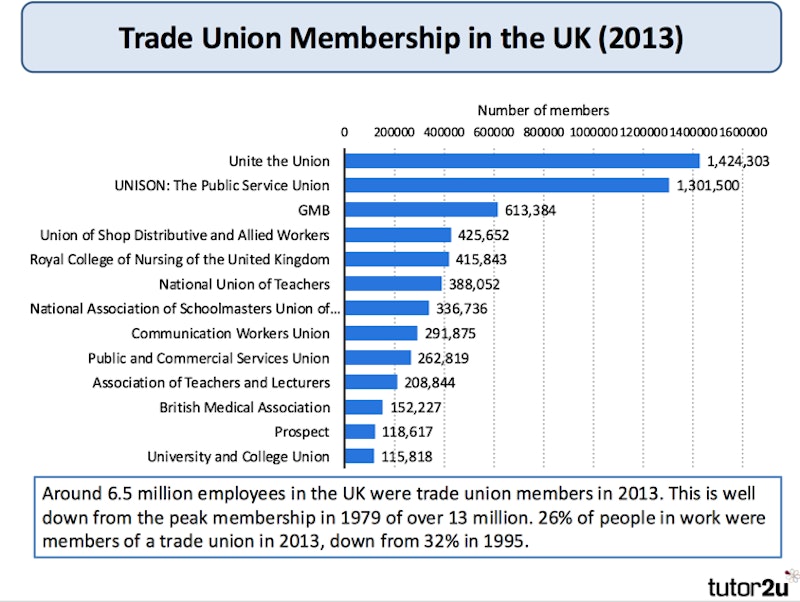Study Notes
People management: what is a trade union?
- Level:
- GCSE
- Board:
- AQA, Edexcel, OCR, IB
Last updated 22 Mar 2021
What is a trade union?
Trade unions are organisations of workers that seek through collective bargaining with employers to:
- Protect and improve the real incomes of their members
- Provide or improve job security
- Protect workers against unfair dismissal and other issues relating to employment legislation
- Lobby for better working conditions
- Offer a range of other work-related services including support for people claiming compensation for injuries sustained in a job
Individual trade unions have historically been associated with specific industries, trades and professions. Examples of trade unions which are still active include:
The two main functions of a trade union are to represent their members and to negotiate with employers. The basic concept behind a trade union is that of increased bargaining and negotiation power which comes from acting together.
Not surprisingly, trade unions often refer to a traditional rallying call – “unity is strength”.
The traditional view of the employer/trade union relationship has been one of confrontation. However, in most cases employers and union representatives have a constructive relationship. Indeed, it is possible to identify several advantages of unionisation from the employers’ point of view:
- Negotiating with trade unions (ideally a single union) saves time and cost rather than dealing with all employees individually
- Unions are part of the communication process between the business and employees
- Employee morale and motivation may be improved if they know that their interests are being protected by a union
- The trade union can be a supportive partner in helping a business undergo significant change

In the UK there has been a long term decline in union membership. In 2008, only 28% of people in a job in the UK were members of a trade union. That percentage is much lower in the private sector where less than one in six employees is in a union. Unionisation is much higher in the public sector – at over 50%.
Trade union membership in the UK has more than halved from its peak of over 13 million in the late 1970’s.
The extent of trade union representation also varies enormously by sector. For example, nearly 60% of people working in education are members of a trade union but only 6% of people in hotels and restaurants and only 11% of people working in wholesale, retail and motor trades
The main reasons for the decline in union membership are:
- Decline in employment in manufacturing (where union membership is traditionally strong) and an increase in employment in the service sector (e.g. retail) where unions are less well established
- Growth in the number of small firms which tend not to recognise (or need) trade unions
- Significant growth in flexible working (part-time, temporary, seasonal) – where employees see less need for union protection
- Improved employee involvement in the workplace – so less perceived need for collective bargaining
Partly as a result of their declining membership, unions now have significantly less power and influence to determine pay and conditions than twenty years ago although in some industries (including postal workers, railway worker, fire fighters and prison officers) unions are still prepared to exert their “industrial muscle”.
Under UK law employers must recognise a trade union in pay and employment discussions when a majority of the workforce want to be represented and has voted for it. But there is little evidence that union members secure any significant wage “mark-up” or greater job protection than people in non-union jobs.
You might also like
Employer & Employee Relations
Quizzes & Activities
Trade Unions and Younger Workers
12th September 2017
Employer Employee Relations
Topic Videos
